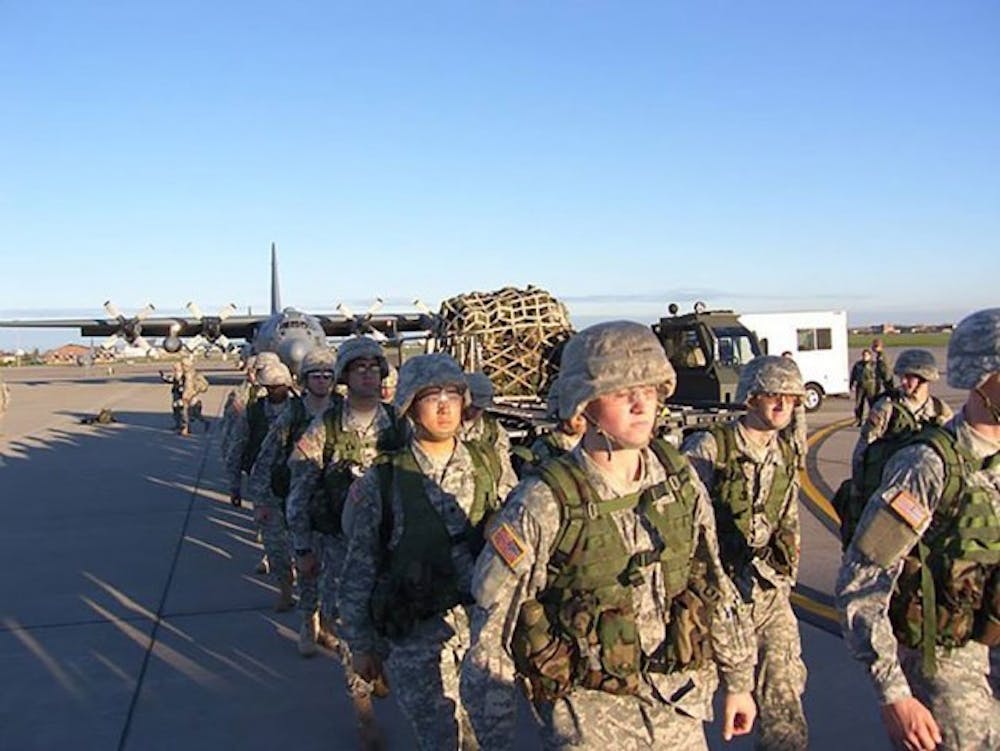About 30 UB students started one weekend in a C-130, a military transport aircraft, to Fort Drum with a view of Upstate New York through huge front windows.
UB ROTC (Army Reserve Officers’ Training Corps) students joined other cadets from the Golden Griffon Battalion in Fort Drum, a U.S. Army military reservation, in late October. The club went for their semesterly Leadership Training Exercise (LTX). This particular training allowed the cadets to apply what they learn and gain experience on a battlefield.
ROTC is “the college elective for undergraduate and graduate students that provides unrivaled leadership training for success in any career field,” according to the U.S. Army’s website.
During this time, the students engaged in simulated scenarios of dealing with military weapons, medical emergencies and avoiding dangerous situations.
“Imagine Xbox Kinect mixed with a Wii, while holding a weapon, and running simulated missions,” said Alfredo Ramirez, a sophomore sociology major and second-year cadet.
The event allowed the cadets to train with modified weapons, which have the same feel, weight, recoil, fit and sounds of an actual weapon, he said.
Campbell Lindsay, a junior physics major and public affairs officer for the UB ROTC Club, said this year’s LTX was much different from past years’ Field Training Exercise.
“This year the focus was taken away from being out in the cold, suffering, learning how to use a map and conducting a small-squad-sized mission,” he said.
Instead of utilizing the old infantry-training model, cadets had the opportunity to understand how current equipment functions and how to apply it one day, Lindsay said.
After riding the C-130, Lindsay said it was a “much smoother ride” than a usual commercial aircraft.
James Spellman, a junior mechanical engineering major and third-year cadet, said they had a chance to visit the cockpit once the plane finished its ascent. He said the amount of controls and meters in the cockpit was overwhelming, but the view was beautiful.
“Being able to see the sun shine through the clouds and vast forests of Upstate New York through the huge front windows of the aircraft was a view unlike any I’ve had during any commercial flights I’ve ever been on,” Spellman said.
Once the cadets arrived at Fort Drum, they began their simulated military training.
In previous years, the cadets would conduct their tactical exercises against the opposition forces, which were other members of their battalion, Spellman said.
“Everyone would hold rubber rifles and yell ‘bang,’” he said. “On this LTX, the simulators gave a realistic feeling because we were actually able to exchange fire with the opposition forces, albeit virtually.”
Spellman said they used two types of simulated rifles. The first rifle replicated a real weapon with a mounted infrared laser to use during training. Targets would pop up and fall over once they registered being hit by the beam.
For the second simulator, cadets held a rifle while looking at a wall-sized screen wearing virtual reality goggles. The room had loud speakers to set the scene of a virtual battlefield.
Lindsay said the simulators added problems and stresses that mirrored real world scenarios.
In their Humvee Egress training, the lights were shut off while the room filled with fog and gunfire sounds blasted from the speakers. The cadets had to then make their way out of the rolled-over four-wheel military vehicle.
The cadets fought off an ambush while giving medical aid, Lindsay said.
To assess medical emergencies at the scene, the cadets were trained in Combat Life Saver (CLS), which is combat “first aid,” Ramirez said.
Ramirez said he was amazed by the technology of the simulated victim and how realistic it looked. He said he could tell it was a male by the features on the head and body structure.
“He had an injured leg that was moving, while the head was shaking side to side,” Ramirez said. “On top of that, he was blinking and gasping for air as his chest rose up and went down.”
Spellman said the mannequins had tubes inside that acted as arteries so the cadets could see when they had to put on a tourniquet, a compressing device, tight enough to stop the bleeding. The trainees would see when the “casualty” had a sucking chest wound or tension pneumothorax that needed to be treated.
Lindsay said over the summer, cadets are sent all over the world to do similar training and improve themselves in the same way others work at jobs or internships.
He said being cadets help them mature faster than the average college student because their decisions immediately affect a larger amount of people and because their actions reflect on the entire Army.
“We all live the Army values,” Lindsay said. “[It] doesn’t stop when we take our uniform off.”
email: news@ubspectrum.com





